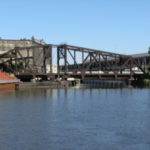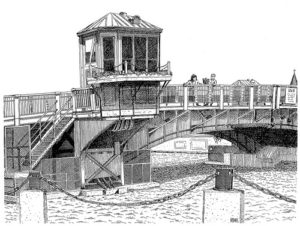A Historic Overview of Milwaukee’s River Bridges
Summary
Drive, bike, or walk around the City of Milwaukee long enough and you will soon encounter one of our local rivers: the Menomonee, Milwaukee, or Kinnickinnic. However, navigating around the city and over these natural features requires innovative bridges that serve pedestrian, vehicular, and river traffic.
The city’s landscape and history were shaped by our rivers and, in turn, by the bridges that were built to cross them. Examples of the important role that bridges played in Milwaukee’s history and identity include the infamous Bridge War of 1845, which led to Milwaukee’s unique “diagonal bridges,” and the Menomonee Valley’s iconic cable-stayed 6th Street Viaduct, modeled after the Milwaukee Art Museum’s addition of the “Brise Soleil Calatrava.”

As Milwaukee moves into the twenty-first century, vehicular traffic continues to increase, the city’s infrastructure ages, and local river bridges require rehabilitation or replacement. The Juneau Avenue Bascule Bridge is being replaced by a lift bridge that costs less to maintain and operate, the Wisconsin Avenue Bridge is undergoing rehabilitation, and many other bridges in the downtown area are also slated for repair and replacement.
Please see the links below for more information regarding the history of our river bridges and the projects scheduled in the upcoming years that will shape the future of Milwaukee’s landscape.
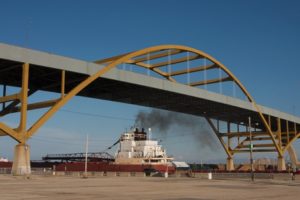
Learn More about Milwaukee’s Bridges:
Milwaukee’s Historic Bascule Bridges
Replacing the Juneau Avenue Bascule Bridge
For more information on Milwaukee’s Bridges visit:
Milwaukee Bridge Overview
GATHERING BY THE WATER
In the Ojibwe language, ominowakiing (or Milwaukee) means “Gathering place [by the water].” One of the main reasons Milwaukee thrived in its inception as a commercial center was due to its easy access to Lake Michigan and the inland access provided by its three major rivers.
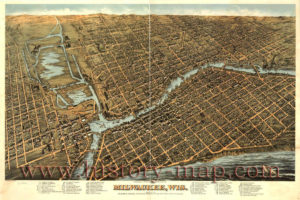
Beginning in the early 1600s, traders, trappers, missionaries, and French explorers used the Menomonee, Milwaukee, and Kinnickinnic Rivers as water routes for transportation. As European settlers moved into the area, local rivers became commercial and shipping arteries for wheat, lumber, coal, and other products. Over time, roads and railways gradually replaced rivers as primary transportation routes, and with this shift came an abundance of bridges linking different areas of Milwaukee.
TYPES OF MILWAUKEE’S BRIDGES
- A Bascule Bridge (sometimes referred to as a drawbridge) is a movable bridge with a roadbed that swings upward and is continuously balanced by a counterweight. The roadbed/span can be one or two leaves and provides clearance for any vessel height. This is the most common type of movable bridge because it opens quickly and requires relatively little energy to operate.
- A Vertical-Lift Bridge (or lift bridge) is a type of movable bridge with a span that rises vertically while remaining parallel with the deck. Generally speaking, longer span lift bridges cost less to build than other movable bridges, such as bascules. The biggest disadvantage of the lift bridge is the height restriction for vessels passing underneath as a result of the deck remaining suspended above the waterway.
- A Swing Bridge is a movable bridge that pivots horizontally from a vertical locating pin and support ring, usually at or near its center of gravity. In its closed position, a swing bridge allows railway or vehicular traffic to cross a river or canal. When a vessel needs to pass under the bridge, road traffic is stopped and motors rotate the bridge approximately 90 degrees horizontally. This provides clearance for vessels of any height but restricts the width of the waterway through which the vessel can pass. This type is commonly used for railroad crossings.
- A Fixed Bridge is a standard bridge that does not move. It is the most common bridge type and does not allow for larger boat traffic to pass below.
BRIDGE OPERATOR HOUSES
A movable bridge requires an operator to raise the bridge for barges, ships, and other tall vessels, such as sailboats. Bridge operators are not only responsible for communicating and ensuring safe passage (see MKE’s bridge operations procedures), but also for maintaining the complex mechanisms of a bascule or lift bridge.
Bridge operator’s houses contain the electrical controls and provide shelter for the bridge operator. They are relatively small structures with windows on all sides so that the operator is able to view incoming vessels from all directions. Bridge operator’s houses are one of the most distinctive and recognizable components of Milwaukee’s bridges. The design aesthetic of operator’s houses range from simple to ornate, and often complement the overall design of the bridge. Their styles reflect the time period in which they were built, and examples include Neoclassical, Art Deco, and Modern designs. Common to all is the tower-like profile and window-filled top story, which enable the bridge operators to view passing vessels.
While many bridge houses remain in Milwaukee, only five were staffed by a bridge operator in 2011. Other movable bridges are operated off-site by a bridge operator using remote cameras and switches, which are connected by fiber optic cables.
MILWAUKEE’S BRIDGES AT A GLANCE
- The City of Milwaukee boasts 179 bridges (pedestrian, rail, and vehicular) as of 2011, and 21 of them are movable: 8 vertical lift bridges and 13 bascule bridges.
IMPORTANCE OF MILWAUKEE’S BRIDGES
The large number of bridges in Milwaukee illustrates how important they are to the commercial vitality of the city. With traffic on certain bridges averaging 13,000 cars per day, a bridge repair or replacement can mean a major inconvenience to drivers and businesses.
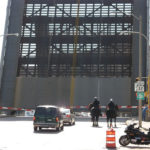
Also, due to the large amount of boat traffic, it is important that boaters are aware of the procedures regarding Milwaukee’s movable bridges. For more information, see the attached operation’s guide below. The City of Milwaukee’s movable bridges are operated by the Department of Public Works.
Milwaukee’s Bridge War
The city founders engaged in fierce competition to keep their settlements separate, and early settlers had strong partisan feelings. In fact, Juneau and Kilbourn purposely built street grids that did not line up. This is the reason why many of Milwaukee’s downtown bridges are on a diagonal (often posing visibility issues for boaters).
The first bridge over the Milwaukee River, at the site of the Juneau Avenue Bridge, was built in 1840 by County Commissioners since east siders and west siders disagreed over costs and maintenance. Disgruntled west siders removed the west side of the bridge on May 8, 1845, touching off what is commonly called the “Bridge War,” and also damaged the west side of the Wells Street Bridge. East siders retaliated with the destruction of the Wisconsin Avenue Bridge and threats to destroy the dam across the Milwaukee River. Several skirmishes broke out between the inhabitants of the two towns, luckily no one was killed, although several people were injured (some seriously).
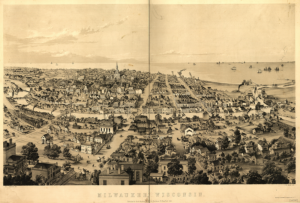
The Village Board was able to diffuse the situation, but final resolution did not come until the Territorial Legislature authorized the construction of three bridges: one at the foot of Water Street, one at Wisconsin Avenue, and one at Cherry Street.
Finally, in 1846, after nearly a decade of contentious rivalry, a legal process to incorporate was undertaken, which resulted in Juneautown, Kilbourntown, and Walker’s Point becoming part of the City of Milwaukee. This occurred two years prior to Wisconsin statehood. After incorporation, the city’s municipal government took over the role of bridge building and maintenance, a function it still provides today.
Milwaukee’s Historic Bascule Bridges
Bascule bridges have one or two movable spans, called a leaf, which rotate vertically on a horizontal, axle-like pin, known as a “trunnion.” The leaf operates much like a seesaw, which is one meaning of the word “bascule” in French. Bascules originated in the medieval castle drawbridge, which provided a water crossing and an effective barricade when raised.
Experimentation with the bascule form began with the need for a bridge that could quickly open and close to facilitate waterway traffic below. Interest in the bridge type began in the early 1890s when Congress gave the War Department the national authority to approve all bridges over navigable waterways and the power to encourage the replacement of those bridges that interfered with the free flow of commerce.
At the end of the nineteenth century, the development of a simple bascule bridge design was pursued in Milwaukee and Chicago in order to enable water vessels to navigate along inner-city rivers while providing crossings for vehicular traffic. As a result, both cities developed similar, yet distinctive, designs for their respective bascule bridges.
The Bridge Division of the Chicago Department of Public Works held a juried competition in 1899 to encourage innovation in bridge design, which was won by Chicago City Engineer John Ericson. The first simple-trunnion bascule bridge utilizing his design was built over the Chicago River in 1902. Designs were developed concurrently in Milwaukee in response to bid requests for the Grand (Wisconsin) Avenue Bridge, and the contract was eventually awarded to the Wisconsin Bridge Company and its simple-trunnion bascule bridge design. The Grand Avenue Bridge was constructed in March of 1902, two months before the bridge in Chicago. The simple trunnion form, now known as the “Milwaukee Type” bascule bridge, was finalized a few years later. Improvements to the design were introduced in the 1904 Emmber Lane Bridge, which became the prototype for future bascules built in Milwaukee.
The simple trunnion bascule bridge is often associated with the City of Chicago, but the “Milwaukee Type” bascule design is believed to have been more widely adopted. According to accounts cited in Historic Highway Bridges in Wisconsin: Moveable Bridges, the “Milwaukee Type” bascule was commonly used due to its ease of design, construction, and maintenance.
The significant difference between the two bascule designs deals with the location of the rack, or operating mechanism that enables the vertical movement of the bridge leaf. The Chicago design utilizes a rear-mounted rack at the back of the bridge leaf, whereas the “Milwaukee Type” features a bottom-mounted rack, below the bridge deck and away from vehicular and pedestrian traffic. In addition, the “Milwaukee Type” utilizes plate girder movable leaves.
MILWAUKEE’S BASCULE BRIDGE EVOLUTION
In 2011, 21 movable bridges were within the City of Milwaukee (13 bascules and 8 lift bridges). Over the last 120 years many bridges have been redesigned, removed, or replaced. Some of the more notable bridges, which illustrate the evolution of Milwaukee’s bascule bridges, are discussed below.
Juneau: The first documented bascule bridge in Milwaukee was a wooden structure along today’s Juneau Avenue, built in 1840. It was the infamous bridge destroyed by residents of Juneautown: the incident that ignited Milwaukee’s Bridge War. Several replacements later occurred, the last being the bascule bridge erected in 1953-1954, which was replaced in 2012 with a lift bridge. For more information, please visit Replacing the Juneau Avenue Bridge.
Clybourn: The first steel bascule bridge in Milwaukee was constructed at Clybourn Street in 1896. The structure maintained a constant center of gravity and the number of moving parts was kept to a minimum. The design was never patented, making it easy to adapt and modify.
Emmber Lane: The final modification that led to the creation of the “Milwaukee Type” Bascule (see above) appeared with the Muskego Avenue/Emmber Lane Bridge of 1904. It was one of the first of this type in the country and was used across the nation due to its simplicity and cost effective operation. This form became the standard in Milwaukee and all 13 spans built in the city before World War II were of this type. The bridge was replaced with a modern bascule bridge in 2000.
State Street: There have been two bridges crossing the Milwaukee River at State Street. The first was an iron swing bridge built in 1871. The second was a bascule bridge constructed in 1924 that was recently rehabilitated. The State Street Bridge is significant as the first bascule bridge designed to meet aesthetic concerns. More attention was given to the aesthetics of the State Street Bascule Bridge than its predecessors, possibly due to the fact that more attention was directed at the waterways as important features of the city and not just as the dreary backwater alleys they had become in the nineteenth century.
Kilbourn Avenue: Unlike other bascule bridges in Milwaukee, the West Kilbourn Avenue Bridge did not replace an existing bridge at the site. The bridge was completed in 1929. Originally planned with two copper-clad operator’s houses almost identical to the State Street Bridge, the Public Works Commissioner desired a grander statement for the avenue that would serve as the main thoroughfare to City Hall. The bridge was designed in the Neoclassical style and featured extensive use of limestone and decorative features that reflected the City Beautiful Movement of the early twentieth century.
THE DECLINE OF THE BASCULE
Following World War II, the volume of boats transporting goods continued to decrease, especially on the Milwaukee River, making bascule bridges less necessary than they had been. Over the course of the last 20 to 30 years, many of Milwaukee’s historic bridges and viaducts have been replaced; however, several have been rehabilitated and retain their original historic features.

Lift bridges, which had their antecedents in the late nineteenth century, are increasingly found along the Milwaukee River due to the end of commercial shipping in the 1960s. This type of bridge, as its name implies, has a center portion that raises vertically to allow for the passage of boats. It is less complex mechanically than the bascule and costs less to operate. With a clearance of typically 25 feet, the vertical lift bridge is well suited to the small pleasure craft that frequent downtown waterways.
For a full, current list of Milwaukee’s remaining movable bridges please visit BridgeHunter.com.
Replacing the Juneau Avenue Bridge
REPLACING THE JUNEAU AVENUE BRIDGE
The Juneau Avenue Bridge was originally known as the Chestnut Street Bridge and was built in 1840. It was the infamous bridge partially destroyed at the beginning of the Milwaukee Bridge War. The Juneau Avenue Bridge, constructed in 1953 and replaced in 2012, was the fifth bridge on the site and was a bascule bridge that spanned the Milwaukee River between Water Street and Old World Third Street.
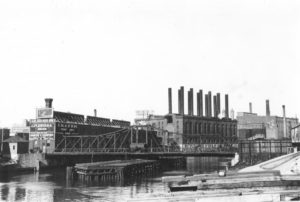
Milwaukee received $14 million in TIGER (Transportation Investment Generating Economic Recovery) stimulus funds to replace the Juneau Avenue Bascule Bridge with a lift bridge, a less costly option in terms of future maintenance and operation. The replacement project also involved total replacement of the bridge operator’s house with a new structure.
[Photo abovecourtesy of Milwaukee County Historical Society]
SIGNIFICANCE OF THE JUNEAU AVENUE BRIDGE
Tentative plans for the current Juneau Avenue Bridge were developed in 1951 by the City of Milwaukee Bureau of Bridges and Public Buildings and featured the “Milwaukee Type” simple trunnion bascule design.
Bridge construction was delayed when concerns were raised that the planned 80-foot bridge width was too narrow. Once the 90-foot bridge width was established, construction was delayed further by a shortage of steel caused by the Korean War. City officials personally went to Washington, D.C. in order to obtain the permissions necessary to purchase the steel. Finally, two years and four months after the decision to build the bridge was made, construction began. It officially opened to traffic on February 1, 1954.
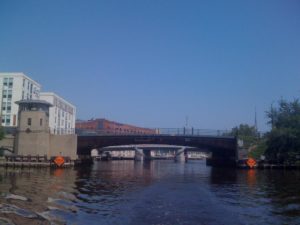
The Juneau Avenue Bridge featured the first single control tower arrangement in Milwaukee, an innovation designed to reduce costs by eliminating one of the bridge operators. Up to this point, bascule bridges in Milwaukee had featured two towers, one for each leaf of the bridge.
However, beginning with the Juneau Avenue Bridge, one tower controlled both sides via the use of a submerged cable. Existing Milwaukee bascule bridges were soon converted to a one-man operation, the first being the 1940 Cherry Street Bridge in 1953. When constructed, the Juneau Avenue Bridge also featured a traffic control system designed to accommodate the variety of situations that could occur with the intersection of boat, vehicular, and rail traffic (as a major rail line crossed Juneau Avenue adjacent to the bridge).
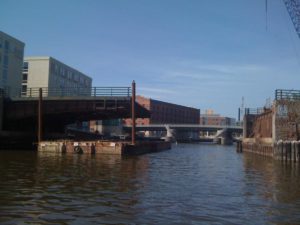
The Juneau Avenue Bridge illustrated the distinctive design features common to the “Milwaukee Type” bascule bridge, including counterweights, leaf superstructures, and operating machinery located below the deck and away from the vehicular traffic area. This design was developed and perfected in Milwaukee.
At the time of its replacement in 2012, the Juneau Avenue Bridge was one of only seven bascule bridges that remained in downtown Milwaukee. As a later example, it represents the continuity of the design from 1924 through the 1950s.



